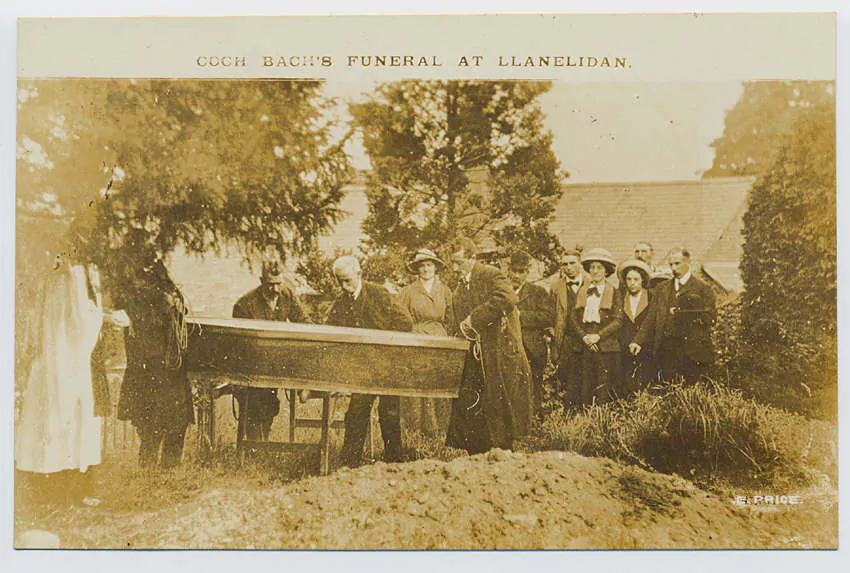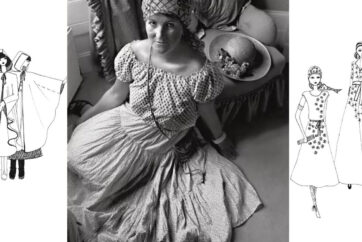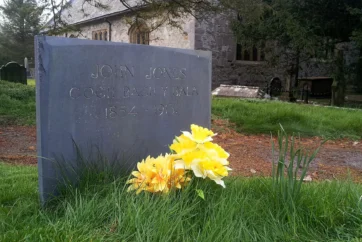Leave the A494 from Ruthin and head south towards Corwen, then turn to the left and drive gently uphill to find a beautiful and unexpected valley. Here is Llanelidan, a place that seems untouched and overlooked. Unchanged even and because of that more connected with the past than the rest of us. It probably wasn’t much different when they laid him to rest.
To find Coch Bach y Bala you will need to visit the Church of St Elidan and look underneath two yew trees at the back of the cemetery. Just follow the main path from the lovely gate, walk around to the back and you will find his grave on the left hand side. It is low black slate and it carries his name. John Jones. Coch Bach y Bala. 1854 – 1913. A simple uncomplicated message, marking the end of a chaotic life.

Church of St Elidan, Llanelidan
Coch Bach y Bala. The little Redhead from Bala. John Jones. He was born in Merionethshire in about 1853 and he achieved a notoriety as a criminal and a folk hero. His exploits, eagerly reported by the press, captured the popular imagination. He was known as many things. The little Welsh Terror, The Little Turpin. His reputation was fuelled by the press, who turned him into a countryside hero, a free spirit. People were happy to buy into this illusion.
Yet what was he? Nothing much more than a petty criminal, an anti-social thief who did time in most of the prisons in North Wales and in England too. He tried a number of different jobs in his time – bricklayer, joiner, seaman, stoker – but he couldn’t get on with any of them. They were too structured. He probably had to follow instructions. And regular employment didn’t exploit his gifts. What he was good at was stealing and he was happy to develop his skills in this area. From his earliest years, Jones continually stole anything he could take, things that were often of no use to him at all. He would store them in hedges and walls, to be collected later. The thieving magpie. Steal it first and then find out whether it would be useful later. In fact he would often boast of stealing things that he hadn’t in an attempt to boost his reputation as north Wales’ leading criminal. But a successful one wouldn’t spend quite as long behind bars as he did.
Until he was 17 he received corporal punishment for his crimes but in 1871 he went to prison for the first time for a month for poaching. A year later he was back inside for 4 months for stealing a knife and an empty purse. In 1873 he stole 13 shillings and was imprisoned for 6 years. Poor John had found the place where he belonged. Prison.
The law always caught up with John Jones and eventually he would accumulate 10 separate convictions for theft, breaking and entering and for rioting against the police in Bala when he threw stones at them. You see, he didn’t like the police very much. They wouldn’t leave him alone. Strangely his subsequent behaviour in prison was generally very good, and he was usually released early on licence.
Apart of course, from this tendency to escape.

Ruthin Gaol
He first escaped from Ruthin Gaol in November 1879. He was awaiting trial for stealing 15 watches in Bala. He opened his own cell door and those of three others before walking out through the main door. The staff were busy eating their supper at the time.
He was on the run for three months, eventually arrested once more whilst he was in bed in the Swan Inn near Colwyn Bay, following a tip off. Following the trial he was imprisoned for 14 years, probably in Dartmoor, a place that was to become his only home.
His second attempted escape followed his conviction at Beaumaris of stealing £10 from the Waterman’s Arms in Amlwch. He was in Caernarfon Gaol waiting to be transferred to Dartmoor again. John Jones was not a happy man. He hadn’t done anything.
For a man who often boastfully claimed responsibility for crimes he hadn’t committed, it seems strange he should make such a fuss about being framed by the police. He was not happy at all. He barricaded the door of his cell with parts of a weaving loom that was in there and started digging a tunnel. He was not successful.
There were occasions when an unreasonable rage would come over him, which was probably a consequence of the mental instability that his behaviour so clearly illustrates. In 1906 he was convicted of burglary and of vicious assaulting a 71 year old woman. He kept the court sitting until 3.00 am whilst he conducted his own defence and addressed the court. On this occasion he was sent to Dartmoor for 7 years. He was released in January 1913. This was his last visit.
For the story has a tragic ending, as these stories often do. Jones was 60 years old and had spent more than half that time in prison. A life wasted in dark and forbidding cells. And on 30 September he found himself in Ruthin Gaol once more. A conviction at Dolgellau Quarter Sessions and a three year sentence, this time for breaking and entering Jordan’s the Solicitors in Bala. They had put him in the lock-up there whilst awaiting trial but he had escaped. They found him in a barn three miles away. After sentencing, he was given another opportunity to enjoy the secure surroundings of Ruthin Gaol, prior to beginning his sentence in Stafford Prison. Previous experience would suggest that Ruthin wasn’t a place he liked very much. This time he tunnelled out of his cell and escaped over the roof of the chapel and the kitchen using knotted sheets as a ladder, in traditional fashion.
The North Wales Times was delighted.

“John Jones effected his escape from Ruthin Prison on Tuesday morning, in a sensational manner. He gained his liberty as the result of indomitable pluck, great astuteness and wonderful ability. Coch Bach is regarded by some as a hero; his performance is certainly a daring piece of work. The daring manner of his escape and the quickness with which he left behind him the precincts of the prison baffled the gaol authorities and the police.”
Coch Bach y Bala was always good copy, a journalist’s dream.
He spent the next week some miles away living rough on the Nantyclwyd Estate. Here he was pursued as if he were a piece of game, a target, a bit of sport. He was shot in the leg by one of the hunters, Reginald Jones- Bateman who was 19 years old. Coch Bach y Bala bled to death in the grass. Jones-Bateman was charged with manslaughter but he had money and the charge was dropped.
His funeral was quite an event, especially with local feeling running so high against the boy with the gun, for he was the son of an unpopular landlord. In shooting John Jones he appeared to have been shooting his tenants who came from the same stock and the same Welsh heritage. Jones – Bateman was not generally surname shared by many on the hill farms of North Wales. Postcards were sold of the place where he was shot and of his funeral, attended by the sort of well dressed people whose houses he had threatened. Finally the Welsh Houdini had been trapped and confined in his grave.

Coch Bach y Bala's funeral at Llanelidan in 1913
Oh yes John Jones, kleptomaniac and poacher, was a colourful character. A good story. A bit of a laugh. The sort of rebel who seems to fight back for the little man against the system. A vagabond perhaps but a loveable rogue.
But he wasted the only life he had. And you wouldn’t have wanted him moving into the house next door to you.
Words: Geoff Brookes
Feature image: The grave of Coch Bach y Bala at St Elidan’s Church, Llanelidan © Cymrodor – CC BY-SA 3.0
Church of St Elidan, Llanelidan © Barrie Price – CC BY-SA 3.0
‘Coch Bach y Bala’s funeral at Llanelidan in 1913 – peoplescollection.wales – CAL





